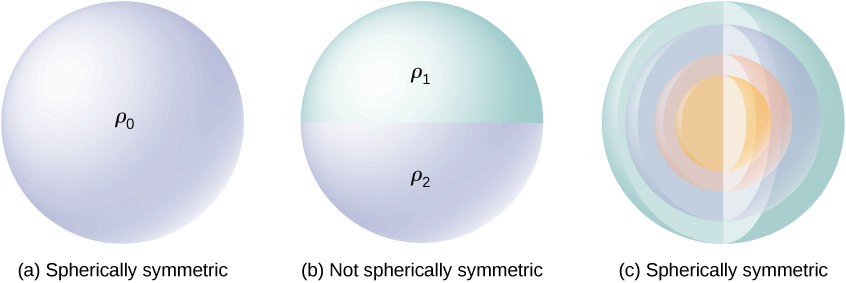| << Chapter < Page | Chapter >> Page > |
A charge distribution has spherical symmetry if the density of charge depends only on the distance from a point in space and not on the direction. In other words, if you rotate the system, it doesn’t look different. For instance, if a sphere of radius R is uniformly charged with charge density then the distribution has spherical symmetry ( [link] (a)). On the other hand, if a sphere of radius R is charged so that the top half of the sphere has uniform charge density and the bottom half has a uniform charge density then the sphere does not have spherical symmetry because the charge density depends on the direction ( [link] (b)). Thus, it is not the shape of the object but rather the shape of the charge distribution that determines whether or not a system has spherical symmetry.
[link] (c) shows a sphere with four different shells, each with its own uniform charge density. Although this is a situation where charge density in the full sphere is not uniform, the charge density function depends only on the distance from the center and not on the direction. Therefore, this charge distribution does have spherical symmetry.

One good way to determine whether or not your problem has spherical symmetry is to look at the charge density function in spherical coordinates, . If the charge density is only a function of r , that is , then you have spherical symmetry. If the density depends on or , you could change it by rotation; hence, you would not have spherical symmetry.
In all spherically symmetrical cases, the electric field at any point must be radially directed, because the charge and, hence, the field must be invariant under rotation. Therefore, using spherical coordinates with their origins at the center of the spherical charge distribution, we can write down the expected form of the electric field at a point P located at a distance r from the center:
where is the unit vector pointed in the direction from the origin to the field point P . The radial component of the electric field can be positive or negative. When the electric field at P points away from the origin, and when the electric field at P points toward the origin.
We can now use this form of the electric field to obtain the flux of the electric field through the Gaussian surface. For spherical symmetry, the Gaussian surface is a closed spherical surface that has the same center as the center of the charge distribution. Thus, the direction of the area vector of an area element on the Gaussian surface at any point is parallel to the direction of the electric field at that point, since they are both radially directed outward ( [link] ).

Notification Switch
Would you like to follow the 'University physics volume 2' conversation and receive update notifications?